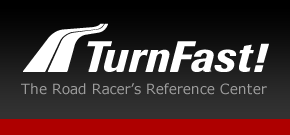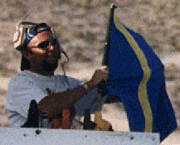Article Topics:
- Overview
- Intro to Racing
- Driving Technique
- Practice Sessions
- Driver’s Gear
- Vehicle Safety
- Handling
- Brakes
- Power
- Tools
TurnFast
recommends
these books:
Articles for Getting Started in Racing
Flags
There are several flags used in auto racing, and for the most part they are used consistently. Below are the typical uses of each flag. However, some organizations use them with slight variations, so the rules may vary club to cluc, and even event to event, so you must always listen to flag rules in drivers meetings as any assumptions of the rules may get someone hurt.
- Green -- starts, or restarts, the session. It may also be shown at the end of a caution zone to indicate it is OK to return to full speed.
- Blue or Blue with Yellow Strip -- give way, faster cars approaching. This will not be used during a battle for position, but will be given to cars much slower, or several positions behind. It is typically not a command, but a suggestion (that should be heeded as soon as safely possible).
- Yellow -- "standing" (not waving) means a local cautionary condition, no passing. Used at all stations during warm up laps, cool down lap, or at affected stations when a car is stopped or off course, and is considered not to be in an imminently dangerous position.
- Yellow -- "waving" usually means a car is in trouble, and may be in an imminently dangerous position to other cars. Proceed with caution, slow your speed until past the hazard, or the next flag station either displaying a green flag, or is not displaying the yellow.
- Yellow with Red stripe(s) -- danger, the track surface is compromised (oil, fluids, dirt, car debris or other contaminant on the track)
- Black Flag - displayed and pointed at your car, or shown with your car number, means return to the pits immediately, you've done something bad. The black flag shown at all stations means the session has been stopped, slow down, no passing, and return to the pits.
- Black Flag with Orange Circle -- mechanical black flag displayed and pointed at your car, or shown with your car number, means return to the pits immediately, your car has a mechanical problem.
- White -- extreme caution, service vehicle or ambulance on the track, or extremely slow car ahead.
- Red -- imminently dangerous conditions that cannot be fixed while cars remain on the track, the race or session has been stopped. If this is shown at a corner station, slow to a stop on the track. Wait for the flag worker to motion you to proceed, at which time drive slowly back to the pits or as directed. Some organizations show the red only at the start/finish and display the black flag at all the corner stations. In this case, do not stop on the track, just continue with caution, no passing, and return to the pits.
- Checkered -- the session or race is complete. Enter the pits on the next time by the pit entrance.
Exactly what the organization will do at the event will always be covered in driver's meetings.
One very important point about flags -- pay attention to all flag stations! It is very easy to ignore them as you get accustomed to the track environment. However, you must make it a mental point to know where each station is, and to remain aware of every station on every lap. This doesn't mean staring at each one as you approach it, but there is typically enough time for a glance at each station. You'll also need to develop the skill of keeping aware of them from your peripheral vision.
The flag workers are there for you and your safety. Pay attention to them as they may be communicating something that will save you and your car from serious harm.
Read Next Article (Track Protocol)


